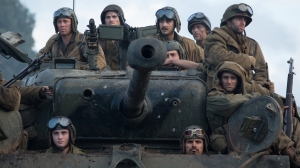The long and prodigious history of war films is a strange and provoking affair. There has always been a distinct difference between the tone and style of a war film based almost exclusively upon which war it is representing. From the broodingly heroic and “morally just” World War II films (told with more dirt and grime when told from the Russians perspective in Hollywood), to the bitter, desperate and psychological Vietnam films, the historical context and political inclinations are what ultimately suade the artistic inclination of a war film. This has, more or less, always been the case, until Fury that is.
Watching Fury is like being in fight – whether you walk away the victor or not, your adrenalin is bursting, your blood is pumping, and you feel exhausted, washed up, and wasted. It is a truly exhausting experience, a genuine edge-of-your-seat thrill-ride that leaves you hot and sweaty, and ready for a nap. Fury is an unrelenting force of gore and barbarism; bloody and brutal images fill the screen from beginning to end with barely a lull in between. The film makes it clear from the start that even the seemingly placid moments between the battles are ticking time-bombs waiting to explode. Anything can happen (And anyone can die) at any moment, and more often than not do.
This intensity is encapsulated in a handful of some of the most stunning set pieces of the year. A particular tank battle half-way through manages to combine fluid explanation, historical accuracy, violent action and stunning visuals with enough skill and craft to make it one of the best scenes of the year. From a gripping opening long to tight explosions, truly director David Ayer has proven himself as a more than capable director and storyteller, ready to give us more.
That being said, Fury is far from perfect. Most pressing and notable is the prolonged third act, encompassed almost exclusively by an all-guns-glazin’ last stand involving the protagonists that is absurdly unbelievable, and serves little purpose other than to undermine the sublime horror of acts one and two. It seems shockingly out of place, an attempt to placate a mass of audiences looking for something familiar in an otherwise unordinary war film.
Some truly exceptionally and shockingly subtle acting comes from nearly all members of the cast. Brad Pitt’s performance is to be expected as well trained, though it is utterly baffling to see Shia LaBeouf with such nuance. So much is expressed by his character by saying so little; light nods and deep stares exchanged between Pitt add a rich layer of intrigue to the already nuanced and developed characters. A rather tumultuous ‘breakfast scene’ exemplifies this, as well as peppering the post-viewing conversation with some much needed gender discourse.
Fury is an exceptional achievement, a powerfully tall flag in the ground for David Ayer and proof that his work should only improve more from here. It is a callous, fierce film, a potent and passionate work that, while flawed, has depth enough to put itself proudly on the pantheon of 2014.

